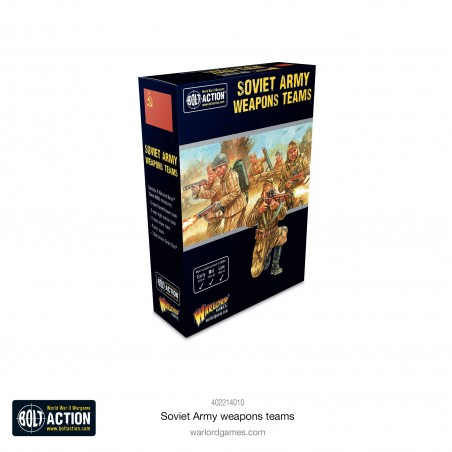- In stock
- -15%






Delivered in time for Christmas? Order only products marked ‘In stock’ before 14 December.Learn more



Soviet Infantry Weapons Teams
Infantry weapons teams are a key component of any Bolt Action army, providing great tactical flexibility. Among the most prevalent are sniper teams, light mortar teams, and flamethrower teams, each posing unique challenges to the enemy.
Soviet Sniper Team
Snipers became synonymous with the Red Army, particularly during the sieges of Stalingrad and Leningrad. Sniper schools were set up in bombed-out buildings and basements, where seasoned snipers passed on their knowledge to an increasing number of students, many of whom were women. Soviet propaganda celebrated successful snipers, fostering a doctrine of sniperism throughout the army.
Equipped with a telescopic sight, Soviet snipers used the bolt-action Mosin-Nagant 1891/30 or, more rarely, the semi-automatic Tokarev SVT-40. They employed various types of ammunition, including tracer and armor-piercing rounds. Available at the company level, snipers worked in teams or alone, while standard infantry squads often included a designated marksman to compensate for the Red Army’s reliance on submachine guns. Renowned for their stealth and patience, the most successful snipers racked up hundreds of confirmed kills, with the highest recorded tally exceeding 500 enemy soldiers.
Soviet Light Mortar Team
The standard Soviet infantry mortar was the 50mm Infantry Mortar Model 1940 (50-PM 40), a cheaper and simplified version of the Model 1938. The Red Army also received a large number of 2-inch mortars from Britain through Lend-Lease. The 50mm mortar was classified as a company-level support weapon, distinguishing it from the heavier 82mm (battalion) and 120mm (regimental) mortars.
Initially deployed as individual teams at platoon level, they were later concentrated at the company level for greater firepower. Highly portable, the 50mm mortar could fire high-explosive or smoke rounds over 800 yards, providing valuable indirect fire support.
Soviet Flamethrower Team
The Soviet Army extensively used flamethrowers, both static FOG-1 versions for defensive positions and man-portable ROKS units for assault and anti-tank roles. Due to a lack of effective dedicated anti-tank weapons, Soviet doctrine emphasized the use of flamethrowers against enemy armor. In 1943, the Red Army even established motorized anti-tank flamethrower battalions.
The ROKS-2 was the most common Soviet flamethrower, cleverly designed to disguise its fuel tank as a standard backpack and its nozzle as a rifle, making it less conspicuous on the battlefield and increasing the operator's survival rate.
Box contains:
Viewed products